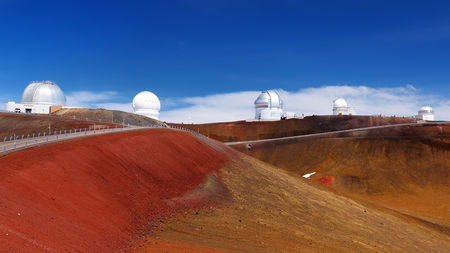Telescopes in Hawaii reopen after deal with protesters – Science Magazine

A dozen observatories on Mauna Kea in Hawaii were shut down for a month because of protests.
MN Studio/iStockPhoto
Astronomers at the 12 observatories atop Mauna Kea in Hawaii returned to work on 10 August, after a deal was made with protesters blocking construction of the Thirty Meter Telescope (TMT).
State authorities brokered the deal, which includes the construction of a temporary roadway built across hardened lava around the protesters’ camp on the summit access road. Law enforcement will give protesters an advance list of all vehicles going up and down—to show that they are not associated with the TMT.
Astronomers are grateful for an end to the 4-week shutdown of the existing observatories—the longest in the 5-decade history of the Mauna Kea observatories. “It was very far-reaching,” says Sarah Bosman of University College London, who lost 3 nights of time to observe distant galaxies with the twin W. M. Keck Observatory telescopes. “Every area of astronomy was affected by this.”
The Canada-France-Hawaii Telescope (CFHT) reported that on its first night back in operation, it located an asteroid called 2006 QV89 that was potentially on a collision course with Earth. Discovered 13 years ago, the asteroid drifted out of observing range before astronomers could get a fix on its orbit. The CFHT was perfectly positioned last month to pin down its trajectory when observations were halted. After a nail-biting month, CFHT astronomers picked up the asteroid’s trail straight away on the night of 10 August. Within an hour of publishing their results on 11 August, researchers at NASA’s Jet Propulsion Laboratory in Pasadena, California, confirmed there was no risk of a collision at any time in the next century—including nine close encounters in the next decade.
The $1.4 billion TMT project, which will be the largest telescope in the Northern Hemisphere, has struggled ever since its groundbreaking ceremony was disrupted by protesters in 2014. Attempts to restart construction were delayed by court battles over the validity of the telescope’s building permit. Opponents say Mauna Kea is sacred and complain that the University of Hawaii mismanages the mountaintop observatories. The protests have also become entangled in issues of Hawaiian nationalism, self-determination, and land rights.
After the court challenges were dismissed and the permit reissued, Hawaii Governor David Ige (D) announced in June that construction would soon restart. But when the appointed day came, hundreds of people had set up camp, blocking the access road. Despite polling showing that most Hawaiian voters support the telescope, crowds reportedly swelled to more than 1000 people at times. Social media campaigns have drawn support from across the globe, including actors Dwayne Johnson and Jason Momoa—who both visited the protest site—and Democratic presidential hopeful Elizabeth Warren. “TMT had done a terrible job with social media,” Bosman says.
Last week, TMT management said it had applied for a building permit at its “plan B” site at La Palma in Spain’s Canary Islands. TMT Executive Director Ed Stone said in a statement that this was simply part of a process that has been going on since 2016 and that Mauna Kea “remains the preferred site for TMT.”
Astronomers are concerned that the TMT has been hijacked by issues that have little to do with science. “The state leadership really needs to be decisive, both on TMT’s access and on these broader issues faced in Hawaii,” says Thayne Currie, an astrophysicist at the NASA Ames Research Center in Mountain View, California, who uses Mauna Kea telescopes. The astronomy community has also made mistakes, he says. “The resolution to this situation will likely include accelerated removal of decommissioned telescopes and Hawaiian land rights and self-determination. TMT and the astronomy community should support these efforts.”
The protests show no signs of slackening. The camp now hosts shops, cafeterias, and lectures. “It’s got to a point where the protesters probably don’t want a compromise anymore,” Bosman says. “It’s hard to see what would be compromise enough.”





